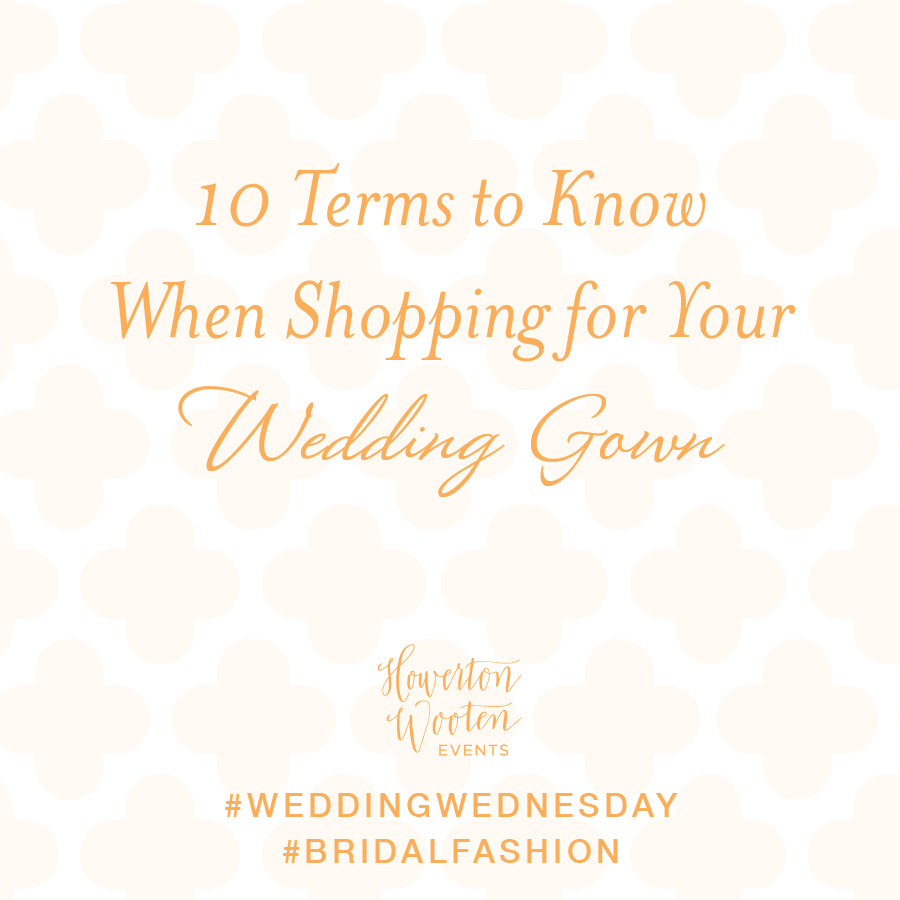
Are you planning to start shopping for your wedding gown? I bet you have heard advice phrases like, “Have Fun” or “Keep an Open Mind.” Of course, this is great advice, but the key to enjoying your shopping experience is being informed.
Educated brides not only feel confident about their purchases, they feel confident about how they look in their wedding gown purchase. So, here are 10 terms we believe you should know as you begin your wedding gown shopping experience.
1. Your Body Type. Are you an “apple,” “pear” or “hour glass? If you have a “pear shape” body, most say that your hips are larger than your bust line, and your waist gradually slopes out to your hip line. An “hour glass” body type typically means that your bust line and hip line are similar in size, but your waistline is smaller. Does your body take on an “apple shape?” Some say this means your waistline is larger than your bust line and the width of your narrow hip line.
2. Dress Measurements. This is the combination of your bust measurements, waist measurements and your hip measurements. Knowing this information is key to having a perfectly-tailored wedding gown. Other measurements, such as your shoulder width and sleeve length could come in hand, but it may not be necessary depending upon the style of your wedding gown.
3. Wedding Gown Sizes. Traditionally, wedding gown sizes run small — So the size 6, size 8 and size 10 wedding gowns typically fit ladies if their regular dress size is a 2, 4 or 6. Some of the more contemporary gown designers are sizing their gown to the modern dress size, but not everyone. So, ignore the dress size when it is brought to you, and don’t let a label (that no one sees) affect your self-esteem.
4. Wedding Gown Silhouettes. Wedding gowns come in many shapes called “silhouettes.” Here are a few of the most popular —
- A-Line Wedding Gown. A wedding gown with this silhouette has a fitted bodice. Then, it flows out from the waist to the floor and resembles the outline of an uppercase “A.” This gown is ideal for brides with pear shape bodies – smaller upper body and large hips.
- Ball Gown. The top of a ball gown is fitted, but the gown flairs at the waist with a full skirt. It is ideal for most body types. However, it doesn’t typically work on petites since the full skirt can typically overwhelm a petite woman’s small frame.
- Empire Gown. A wedding gown with an Empire waistline works well for brides with “apple” body type. An Empire gown’s waistline begins just under your bust line. The skirt of the gown flows into a gradual floor-length A-line wedding gown.
- Mermaid Gown. This wedding gown style has a silhouette that hugs a woman’s curves. This gown flairs out at the bottom like a mermaid’s fin.
- Trumpet Gown. The trumpet wedding is often confused with the Mermaid-style wedding gown because both silhouette styles are formfitting. However, the trumpet-style wedding gown is fitted from your breast to your knees, and it gradually flares out to above your knees. This gown is ideal for brides with hourglass and/or slender body types.
5. Appointments. To ensure you receive the full “experience” of shopping for your wedding gown, we highly recommend making an appointment in advance. And, if you have a little flexibility at work, make that appointment for a weekday (instead of a Saturday).
6. Lead Time. The amount of time it takes to receive your gown varies. Ordering your wedding gown a minimum of six months out is a good start, but 8 months is better because you need time for your wedding gown to be delivered AND you will need lead time for your “dress fittings” (see below).
7. Dress Fitting. After a bride purchases her wedding gown, the next step is to make sure her wedding gown “fits” her body perfectly. So, she meets with the salon’s seamstress for “dress fittings” to have the gown altered to fit her body exactly. Typically, a bride will have 2 to 3 dress fittings that could take place over 6 to 8 weeks.
8. Pre-Owned Wedding Gown. This is a gown that has already been worn by another bride on her wedding day. This wedding gown is typically in pristine condition, so no one (other than the bride purchasing the gown) knows that another bride wore the wedding gown first. The appeal of “pre-owned” wedding gowns is the price — A budget savvy bride can grab a designer gown at a deeply discounted price.
9. Sample Sale. Wedding gown designers host sample sales when they have too much inventory in-house, and they need to move it to make room for a new season (or a new line) of wedding gowns. Some of the gowns may come from a previous fashion year or they might need a bit of tailoring. Sometimes these samples may have been previously used by bridal salons.
10. Trunk Show. This is an event, typically held at a bridal salon, where a wedding gown designer (or a sales and marketing executive from the wedding gown designer) visits a bridal salon on a predetermined day with his or her line of new gowns. The salon announces the trunk show in advance, so that brides can schedule appointments to try on the gowns and meet with the designer (or the sales executive).
Best of luck as you begin shopping for your wedding gown. And, remember to keep an open mind and have fun! (wink)
Love & Soul Always, Kawania